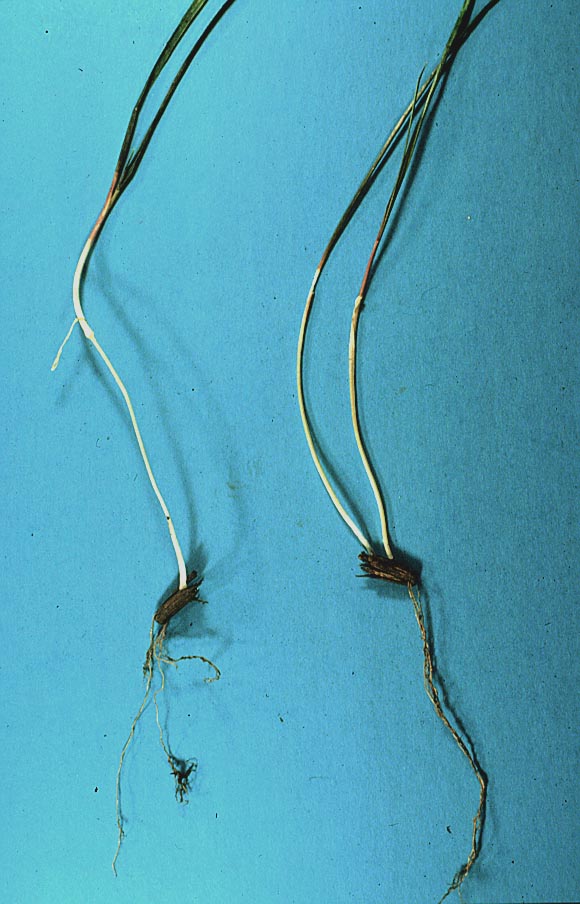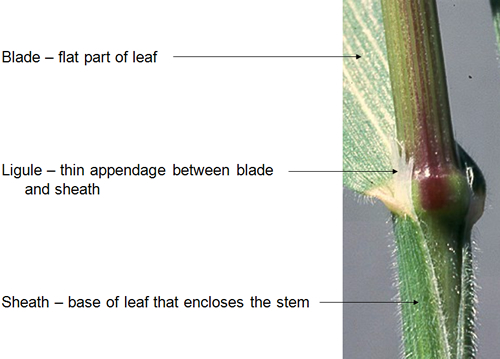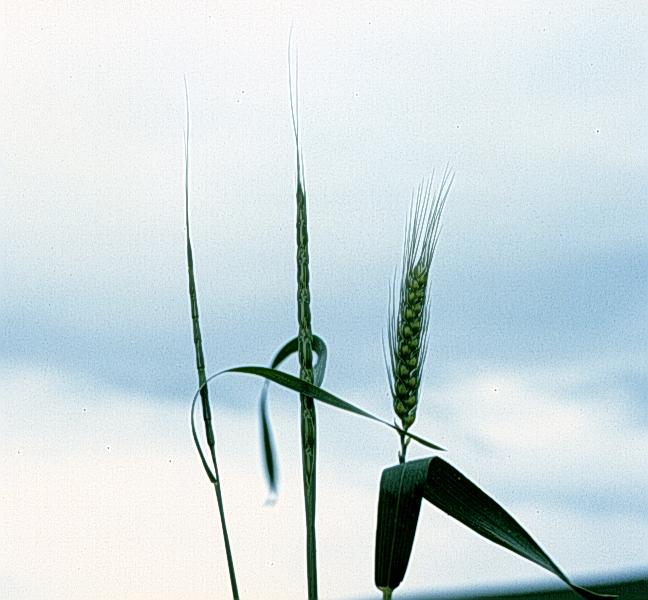Winter wheat (Triticum aestivum L.), jointed goatgrass (Aegilops cylindrica Host), and downy brome (Bromus tectorum L.), all of which are winter annual grasses, often grow side-by-side. Figure 1 identifies the blade, ligule, and sheath of a grass plant.
Jointed goatgrass seedlings appear very similar to wheat seedlings, except jointed goatgrass leaves have a number of visible hairs growing along the edge of the leaf (Figure 2). Wheat leaves are generally hairless. If hairs do appear on wheat leaves, they will be sparse, as well as longer and more randomly spaced than the hairs on jointed goatgrass leaves. The sheath on both wheat and jointed goatgrass is hairless. The sheath and leaf blade on downy brome are covered with soft dense hairs (Figure 3). To positively identify jointed goatgrass in the early seedling stage, dig up a plant and look for a spikelet (joint) attached to the root (Figure 1).
Jointed goatgrass may also be growing alongside volunteer rye (Secale cereale L.). Volunteer rye, also known as feral rye, common rye, or cereal rye, is another winter annual grass that is a problem weed in winter wheat. It is very difficult to distinguish volunteer rye seedlings from winter wheat seedlings. Volunteer rye seedlings may be a darker green color, or the leaves may be slightly wider. To positively identify volunteer rye, dig up a plant and look at the seed.
As jointed goatgrass begins to head, it is easy to distinguish from wheat, downy brome, or volunteer rye. The head of jointed goatgrass, also called the spike, is a long narrow cylinder. This spike is made up of a number of spikelets, also called joints (Figure 4).
Each spikelet (joint) is about one-half inch long and contains from one to three seeds. At maturity, which normally occurs 2-3 weeks before wheat is harvested, part of the jointed goatgrass spike will often break off and the spikelets will fall to the ground. Spikelets that remain attached to the jointed goatgrass stem, and are harvested with the wheat, will look like short pieces of straw mixed with wheat in the combine bin. Wheat straw is hollow, however, while jointed goatgrass spikelets (joints) are closed on both ends.
Occasionally, wheat and jointed goatgrass will cross and produce a hybrid plant. When mature, this hybrid will share the appearance of both the parent plants (Figure 5). Seeds from these hybrid plants are almost always sterile.
A key to managing jointed goatgrass is understanding the survival of jointed goatgrass seeds in the soil. After one year, 80 percent or more of jointed goatgrass seeds may still be viable. After two years, 20 percent may be viable, and after 3 years, 5 percent may be viable. This is in sharp contrast to downy brome, which may have less than 20 percent seed viability after 1 year.
Seed survival is a major reason that jointed goatgrass is difficult to control in wheat. Because 20 percent or more of jointed goatgrass seed can survive 2 years or more, even after a year of fallow there may be a significant amount of viable jointed goatgrass seed in the soil. This reservoir of viable weed seed is called the soil seed bank. Some of this seed then germinates and establishes new jointed goatgrass plants in the next wheat crop. These new plants produce even more seed, further infesting future wheat crops.
As part of this multi-year seed survival, jointed goatgrass has staggered seed dormancy. As discussed earlier, jointed goatgrass seeds are contained in spikelets (joints). Each spikelet contains from one to three seeds. Even under optimum conditions, not all seeds within a spikelet may germinate at one time.
Jointed goatgrass can germinate on the soil surface, or it can emerge from as deep as 4 inches in the soil. In comparison, downy brome will rarely emerge from depths greater than 2.5 inches. Shallow tillage to incorporate jointed goatgrass spikelets into the soil may stimulate germination, but the results vary. Again, this is in contrast to downy brome where even a small amount of seed-soil contact will greatly increase germination.
Typically, jointed goatgrass emerges from September through early November, goes dormant over the winter, and heads out to produce seed in spring. A secondary flush often emerges in early spring. Jointed goatgrass plants that emerge in early spring can produce heads that may contain viable seed, even if the time for vernalization was very short. This makes late spring-planted crops such as corn, sunflower, or proso millet more effective in a rotation to control jointed goatgrass than early-spring planted crops such as oats or spring wheat. Jointed goatgrass generally heads after downy brome, but before wheat.
One other difference between jointed goatgrass and wheat is that anthesis (the period during which flowers in the emerged head are pollinated and become viable seeds) is much longer for jointed goatgrass than for winter wheat. Anthesis in both plants is identifiable when anthers (small, yellow cylinders of pollen) are visible on the heads. A long anthesis gives jointed goatgrass a better opportunity for favorable weather during anthesis and helps ensure seed production.
Another management concern is the ability of jointed goatgrass to produce viable seeds shortly after heading. The first heads to emerge on a jointed goatgrass plant may produce viable seeds before other heads on the same plant have even emerged. This means control of jointed goatgrass plants must be done in a timely manner, preferably before any heads have emerged, to prevent the production of seed.
Jointed goatgrass reduces wheat yield by competing with wheat for sunlight, soil moisture, and soil nutrients. It is an especially good competitor under stressful conditions, such as drought. A general guideline is that one jointed goatgrass plant per square yard will reduce wheat yield by 1%. Producers should remember that one jointed goatgrass plant can produce dozens of seeds, leading to many more jointed goatgrass plants in the next wheat crop. Jointed goatgrass populations and wheat yield losses from these populations can quickly become severe.
Further information on jointed goatgrass identification and biology can be found in the bulletin “Jointed Goatgrass Ecology”. It can be viewed and downloaded on the Bulletins page of this website or is available through university extension specialists.




